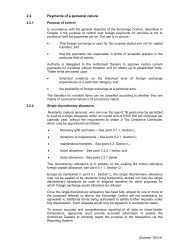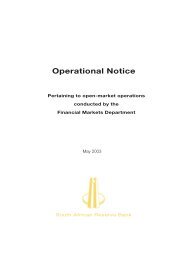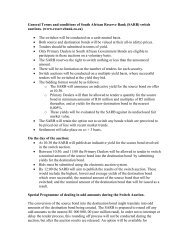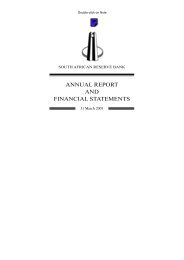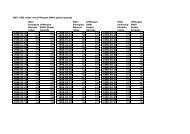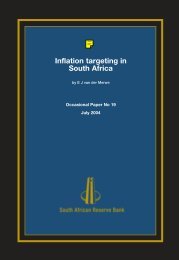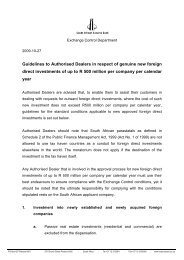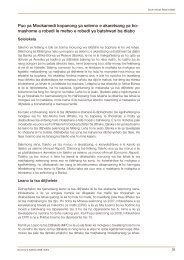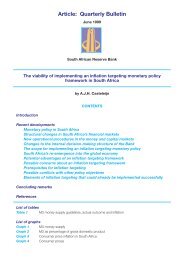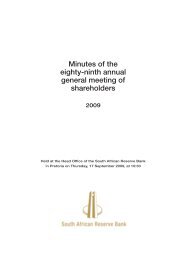Signaling currency crises in South Africa - South African Reserve Bank
Signaling currency crises in South Africa - South African Reserve Bank
Signaling currency crises in South Africa - South African Reserve Bank
Create successful ePaper yourself
Turn your PDF publications into a flip-book with our unique Google optimized e-Paper software.
SARB Conference 2006If it is assumed that the data po<strong>in</strong>ts of the time series can be described as normally distributed,the calculation of <strong>crises</strong> thresholds will almost certa<strong>in</strong>ly lead to the identification of some eventsas <strong>currency</strong> <strong>crises</strong>, depend<strong>in</strong>g on the heights of the threshold. The version prom<strong>in</strong>ently used <strong>in</strong>the graphical analysis above was a threshold of the mean of the time series plus 1,645 itsstandard deviation. That threshold is used, <strong>in</strong> l<strong>in</strong>e with e.g. Bhundia and Ricci (2005: 157) andCaramazza et al. (2000), because it will identify five percent of the months as crisis months(outly<strong>in</strong>g of a one-sided 95 percent confidence <strong>in</strong>terval) if the time series is normally distributed.Obviously discrete changes <strong>in</strong> the threshold lead to more, or less, detected <strong>crises</strong>. It is also forthat reason that the crisis identification by this measure is largely method dependent. As seenabove, the crisis detection is also dependent on the sample period and the weights of the threemeasures <strong>in</strong> the <strong>in</strong>dex. Additional conditions, such as an additional annual depreciationcriterion, counteract the potential identification of <strong>crises</strong> <strong>in</strong> periods where there have not beenany serious events. However, depend<strong>in</strong>g on the threshold of this criterion, more or less <strong>crises</strong>are identified and the criterion may let <strong>crises</strong>, <strong>in</strong> which the depreciation has been held <strong>in</strong> checkby <strong>in</strong>terventions <strong>in</strong> money or foreign-exchange markets, go undetected. Thus, the technicalanalysis of EMP <strong>in</strong>dex figures cannot be a substitute for careful economic analysis of events. Itmay also be worthwhile to look at the impact of episodes on <strong>currency</strong> markets on othermacroeconomic aggregates such as <strong>in</strong>flation and economic growth, which may be closer toeconomic wealth and can therefore be a better <strong>in</strong>dicator of whether a certa<strong>in</strong> event is a crisis ornot.The results of the analysis above (April 1996, June/July 1998, December 2001) are still used <strong>in</strong>the rema<strong>in</strong>der of the paper, s<strong>in</strong>ce the f<strong>in</strong>d<strong>in</strong>gs are <strong>in</strong> l<strong>in</strong>e with what had already been detectedas <strong>currency</strong> <strong>crises</strong> <strong>in</strong> the literature.<strong>Signal<strong>in</strong>g</strong> <strong>currency</strong> <strong>crises</strong> – a literature reviewThe theoretical literature on <strong>currency</strong> <strong>crises</strong> is centered on the paradigm of the threegenerations of <strong>currency</strong> crisis models. The first generation, owed to Krugman (1979) and Floodand Garber (1984), describes <strong>currency</strong> <strong>crises</strong> as speculative attacks which result from monetaryor fiscal policies that were not <strong>in</strong> l<strong>in</strong>e with a fixed exchange rate target. The run on foreign<strong>currency</strong>reserves occurred because market participants could foresee the depreciation andtried to avoid losses. The models described the <strong>currency</strong> <strong>crises</strong> of the 1970s and 1980s <strong>in</strong> Lat<strong>in</strong>America. The second generation, based on Obstfeld (1986), stresses the trade-off between thecentral banks’ <strong>in</strong>tentions to target a fixed exchange rate and to follow other policy targets, e.g. toachieve low levels of unemployment. If speculators assume that the policy response could bedevaluation, the event may become self-fulfill<strong>in</strong>g without (<strong>in</strong> contrast to first generation models)worsen<strong>in</strong>g economic fundamentals. The models addressed, for example, the EMS <strong>crises</strong> <strong>in</strong>Europe. Third-generation models stress the connection between bank<strong>in</strong>g and <strong>currency</strong> <strong>crises</strong>,and address problems such as contagion of <strong>crises</strong> and herd effects. These models weredeveloped <strong>in</strong> response to the Asian crisis of 1997/1998.The empirical literature on signal<strong>in</strong>g or forecast<strong>in</strong>g <strong>currency</strong> <strong>crises</strong> is based on the theorytransmission processes described above, but approaches vary with regard to the employedtechniques. Standard approaches are bivariate Logit/Probit models and signals approaches asdeveloped by Kam<strong>in</strong>sky and Re<strong>in</strong>hart (1996, 1998). 14 Logit/Probit models use the bivariatevariable crisis/no crisis as endogenous variable and estimate the impact of different sets ofexplanatory variables. 15 Signals approaches are non-parametric approaches that exam<strong>in</strong>e thebehavior of potential explanatory variables prior to the detected <strong>crises</strong> and compare it with non<strong>crises</strong>periods. If some of the variables pass a certa<strong>in</strong> threshold their changes are used as crisissignals. 16 Besides these two techniques, further concepts are outl<strong>in</strong>ed <strong>in</strong> the literature. These<strong>in</strong>clude artificial neural networks (ANN), the advantage of which is the reflection of complex14 For a more detailed survey on Early-Warn<strong>in</strong>g Systems presented <strong>in</strong> this section see Abiad (2003).15 Examples <strong>in</strong>clude Berg and Pattillo (1999b), Kam<strong>in</strong>, Sch<strong>in</strong>dler and Samuel (2001), and Kumar, Moorthy andPerraud<strong>in</strong> (2002).16 See Brüggemann and L<strong>in</strong>ne (2002). Other examples <strong>in</strong>clude Berg and Pattillo (1999b), and Edison (2000).Knedlik 207



